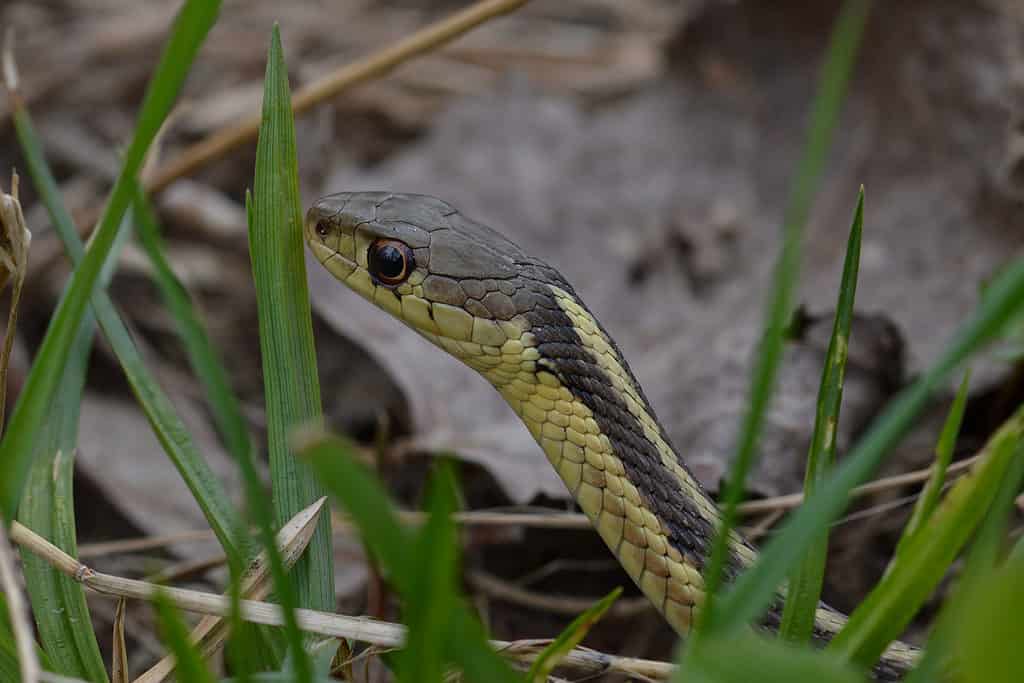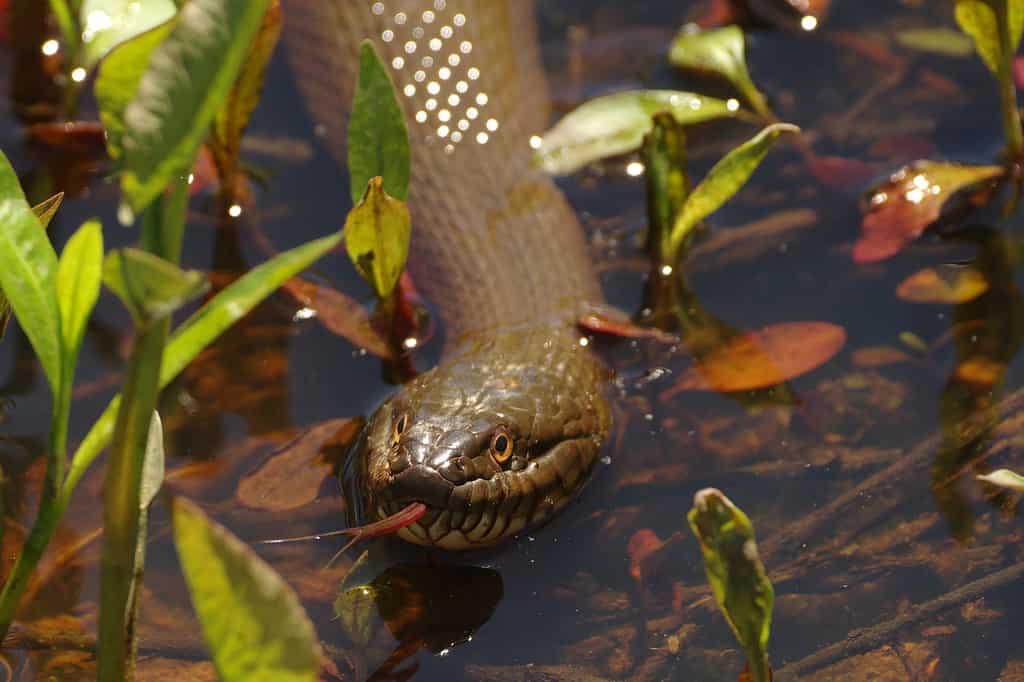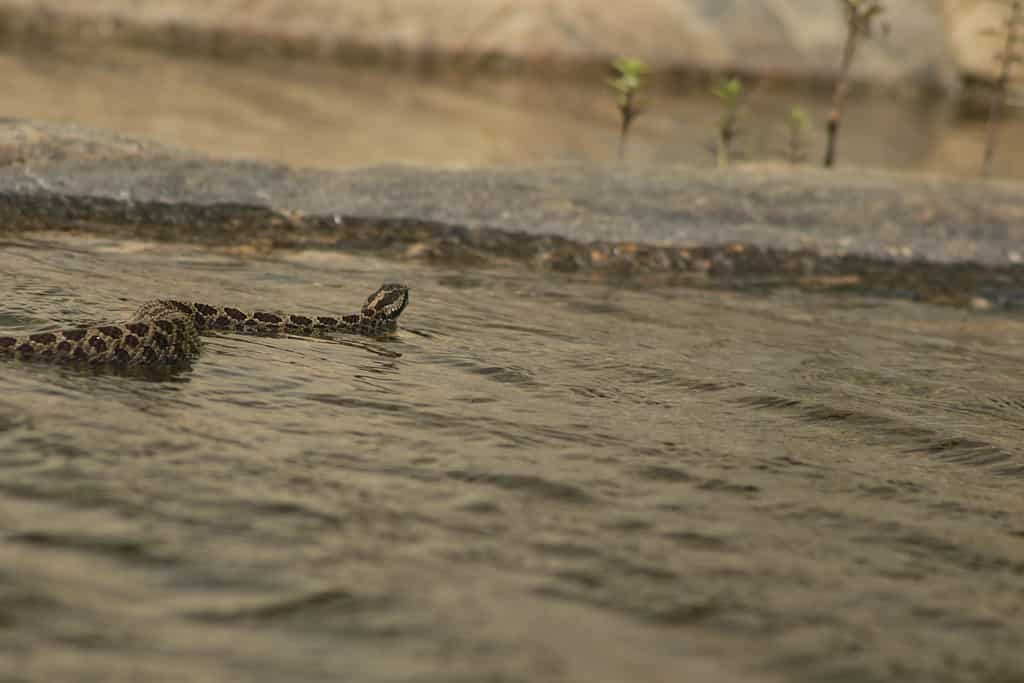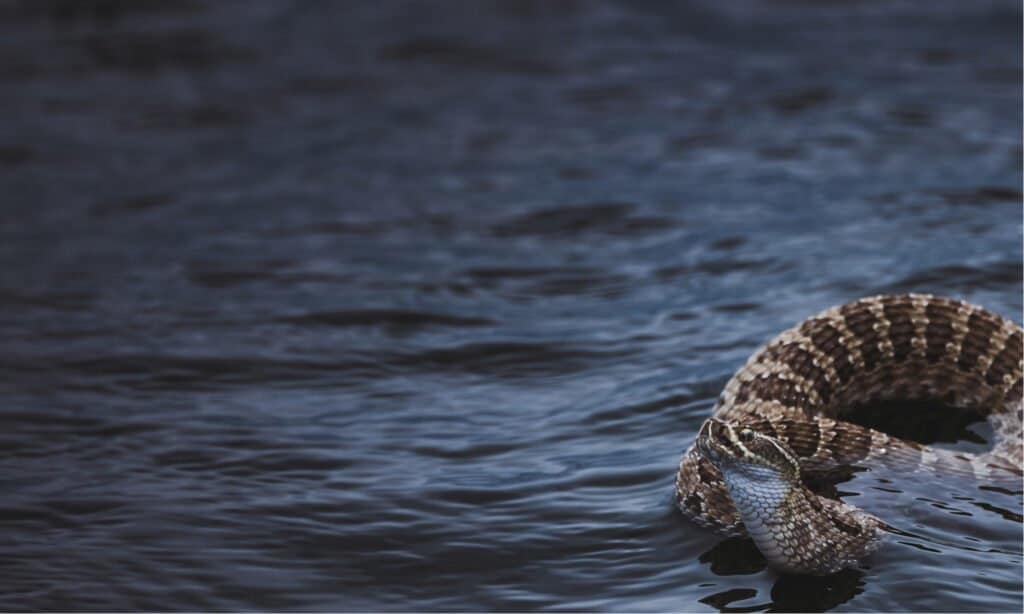The province of Quebec has hundreds of lakes, reservoirs, and bodies of water to explore. Nature lovers and adventure seekers have the world laid at their feet within the captivating world of Quebec’s lakes. Part of the natural beauty of these places, however, is the diverse snake populations teeming in the waves.
Beneath the surfaces of Sylvan Lake, Lake Pink, and some other lakes, a variety of snakes slither. Though mostly nonvenomous, some of the snakes on the shorelines and under the waters in Quebec still bite. However frightening snakes look, they remain an essential part of Quebec lakes’ ecosystems and help to maintain balance and order. As public opinion for snakes in the Quebec grow in discomfort, education is crucial to maintain and preserve the delicate balance in the ecosystems that the snakes in lakes support.
Do you know which of Quebec’s lakes have the most snakes? Keep reading to discover the five most snake-infested lakes in Quebec and learn about their top amphibian inhabitants.
Common Snake Species in Quebec

The Eastern garter snake (
Thamnophis sirtalis) travels on land and water.
©Ryan Hodnett, CC BY-SA 4.0, via Wikimedia Commons – License
Canada’s largest province by land area has a large variety of vegetation throughout its limits. Discover some of the most common snakes — most of which are aquatic — that swim and slither in Quebec.
Eastern Garter Snake
The eastern garter snake (Thamnophis sirtalis) is the most common snake to find in the lakes of Quebec. Known for its vibrant, distinctive markings and friendly disposition, the eastern garter snake lives on both land and water. These snakes are often seen sunbathing near water bodies and are excellent swimmers, making lakeshores and marshy areas their preferred habitats.
Northern Red-Bellied Snake
The northern red-bellied snake (Storeria occipitomaculata) dwells in forested areas and grasslands around Quebec’s lakes as they hunt for insects and earthworms. These non-venomous snakes control pest populations and try their best to stay away from humans.
Eastern Milk Snake
You have a good chance to come across the eastern milk snake (Lampropeltis triangulum), a non-venomous species known for its diverse color patterns. While these striking snakes bring a moment of shock when unexpectedly encountered, they’re usually harmless. You’ll find these snakes in the woodlands and open fields right around Quebec’s lakes.
Northern Watersnake
The variable landscapes around the lakes of Quebec provide a suitable habitat for the northern water snake, a semi-aquatic snake that thrives in wetland areas, ponds, and rivers. They are skilled swimmers who prefer to hunt fish and other small amphibians on the lake.
Common Watersnake
Of the two types of water snakes in Quebec, the common watersnake (Nerodia sipedon) rears its head out of the water even more than its cousin, the northern watersnake. The common watersnake remains a subspecies of the common garter snake and likes to slither around the western and southern parts of Quebec in grassy lowlands near freshwater sources.
Smooth Green Snake
Lastly, the smooth green snake (Opheodrys vernalis) moves quietly through Quebec’s meadows and grasslands with its bright green skin. These docile snakes are masters of camouflage and often blend seamlessly into the surrounding foliage. Smooth green snakes’ diet mainly consists of insects.
Sylvan Lake Snake Species and Behavior

Lake Sylvan’s calm waters make it a perfect home for some aquatic snakes.
©Angelito de Jesus/Shutterstock.com
Sylvan Lake boasts stunning vistas and abundant wildlife. It’s also the most snake-infested lake in Quebec and Canada, even earning the title “Snake Lake” from early French settlers. With its diverse ecosystems and rich biodiversity, Sylvan Lake offers a front-row seat into the world of snakes.
The eastern garter snake calls Sylvan Lake home, as well as the northern red-bellied snake, the eastern milk snake, and the common garter snake. The garter snake population, in particular, gave the lake its moniker in 1899 which didn’t change until years later, when the residents realized “Snake Lake” might be off-putting to tourists.
During warmer months, the snakes at Sylvan Lake become more active as they seek basking spots near the water’s edge to regulate their body temperature. Furthermore, some non-native snake species undertake seasonal migrations to Lake Sylvan to find ideal nesting sites. These migrations contribute to the dynamic ecosystem of Sylvan Lake.
Lake Massawippi Snake Species and Behavior

A Northern water snake (
Nerodia sipedon) swims in a marsh pond.
©Philip Yabut/Shutterstock.com
Lake Massawippi is a captivating water body located in the Estrie region of Quebec. In the nineteenth and twentieth centuries, wealthy Americans tended to frequently this lake often for its luxury hotels. In Abenaki (the language of an indigenous tribe in Canada), the name “Massawippi” means “the big deep lake.”
As the second-most snake-infested lake in Quebec, it’s no surprise that Lake Massawippi hosts a diverse array of snake species. The northern watersnake, the eastern garter snake, and the northern brown snake, are just a few of the snakes slithering around the shoreline and its surrounding vegetation.
During the warmer months, the northern watersnake swims in the lake and hunts for fish and small animals near the edge of the water. You may even see it basking on rocks or logs, using the warmth of the sun to regulate its body temperature.
The eastern garter snake will spend most of its time hunting in and out of the water, on the lookout for small mammals, insects, and even other snakes. It is one of the most versatile species that call the lakeside of Quebec home, with the distinct ability to survive across different landscapes.
Finally, the northern brown snake prefers wooded habitats and avoids humans. However, the woods around Lake Massawippi provide the perfect habitat, so they’ll be spotted more often than not slipping through leaf litter near the shoreline.
Lake Pink Snake Species and Behavior

All species of milk snakes have alternating colors of light and dark.
©Jay Ondreicka/Shutterstock.com
Lake Pink is home to a fascinating array of snake species, each adapted to thrive in this unique environment. The species on and around the lake include:
- The eastern milk snake, one of the prominent residents of Lake Pink.
- The smooth green snake, which slithers through Lake Pink’s meadows and grasslands.
- The northern ring-necked snake.
In Lake Pink specifically, these snakes play a crucial role in controlling rodent populations, which maintains a balance that prevents overgrazing and damage to vegetation.
The eastern milk snake feeds on small mammals; the smooth green snake controls insect populations that could otherwise lead to imbalances within the ecosystem, and the northern ring-necked snake plays a vital part in the food web by preying on small invertebrates, thereby impacting their abundance and distribution in the environment.
Lake Temiskaming Snake Species and Behavior

Eastern massasauga
rattlesnakes
are venomous snakes that can be found in lakes and rivers.
©mynewturtle/Shutterstock.com
Lake Temiskaming is home to a diverse array of snake species, making it a perfect addition to the list of snake-infested lakes in Quebec. The eastern massasauga rattlesnake, a venomous species; the eastern garter snake; and the eastern milk snake can be found around Lake Temiskaming navigating the rocky outcrops.
Unfortunately, a lack of education has led to the accidental and fear-based hunting of snakes around Lake Temiskaming. This poses some issues, as the snake population at Lake Temiskaming contributes to the overall ecological health and human interactions challenge their conservation. Furthermore, this jeopardizes snake populations which in turn affects the circle of life and food web at the lake, unintentionally shifting the ecosystem.
Lake Magog Snake Species and Behavior

A northern water snake slithers on the bed of Lake Magog.
©Chris Dale/Shutterstock.com
Last on the list of snake-infested lakes in Quebec is Lake Magog. Nestled amidst Quebec’s eastern townships, Lake Magog has pristine waters and a surrounding marshland that provides a haven for a diverse array of wildlife, including several snake species that contribute to the region’s ecological integrity.
Lake Magog hosts snake species like the northern watersnake, the eastern garter snake, and the smooth green snake. Each of these species has a specific role to play in the ecosystem — with the northern watersnake spending most of its time on the waves and the smooth green snake navigating through the meadows.
Officials in Quebec have worked hard to make Lake Magog a focal point for preservation efforts. Most of these preservation initiatives want to protect the unique biodiversity, including that of the snake population. Conservationists and local communities have collaborated to protect critical habitats, establish wildlife corridors, and implement educational programs to raise awareness about the importance of preserving these ecosystems.
Factors Attracting Snakes to Lakes

Snakes frequent water sources for hunting and habitat reasons.
©Clint Lockwood/Shutterstock.com
Understanding the reasons behind snake habitats in lakes helps visitors and locals who frequent these places to gain respect for the animal. It also fosters an appreciation for the beauty of delicate ecosystems and helps humans maintain the environments around the snake-infested lakes in Quebec for safe co-habitation with snakes.
Environmental Factors
The proximity to the water provides a consistent source of hydration that helps their bodies regulate temperature. Lakesides and their surrounding vegetation and terrain offer ample opportunities for cover, shelter, and camouflage, which allows snakes to thrive while remaining relatively hidden from potential threats. This cover also helps them hunt prey.
Abundance of Prey
Based on the snake species mentioned above, many of the snakes that frequent these lakes in Quebec do so for the abundant availability of prey. These water bodies are natural hunting grounds with a food web in which snakes play a significant role. Small fish eat even smaller fish or insects, and then the snakes eat those fish. In turn, larger snakes or birds drinking from the water will feed on the snakes.
Suitable Nesting and Shelter
Lakesides offer ideal nesting and denning locations for many species of snakes, including the common watersnake. These wet habitats and environments ensure the snake babies (snakelets) can avoid predators, learn to become predators themselves, and have handy access to a water source when they’re thirsty.
Water Sources
Lastly, water makes the world go around — even for snakes. Did you know that some snakes even mate in the water? Both aquatic, semi-aquatic, and land snakes need access to fresh water to regulate their body temperatures, drink, and find food that lives in freshwater.
The Ecological Role of Snakes
Snakes play a vital and often under-appreciated role in maintaining the balance of ecosystems of the lakes in Quebec. By understanding and acknowledging their role in the circle of life, visitors and locals to the most snake-infested lakes in Quebec can foster a deeper appreciation for these creatures.
Snakes are a natural solution to controlling rodent and insect populations, especially in the wooded and prairie areas of Quebec. As rodents reproduce rapidly and become a nuisance to agricultural, urban, and natural environments, snakes intervene as regulators. By preying on rodents and insects, snakes help prevent overpopulation. This reduces the potential spread of disease, the amount of agricultural damage, and keeps the snakes themselves healthy. This delicate balance, fostered by snakes, keeps rodent numbers in check and avoids negative effects on other components of the ecosystem.
As predators, snakes control unwanted populations of rodents and insects. As prey themselves, they help to feed other populations (like larger snakes, hawks, foxes, and raccoons) and continue the circle of life from another side of the coin.
Overall, the role of snakes in Quebec’s ecosystem helps to maintain effective predator and prey relationships between all the native species in the province.
Understanding and Avoiding Snake Encounters
To minimize the likelihood of snake encounters while exploring the landscapes of Quebec, practice caution and awareness as you move through the natural world. Be mindful of where you place your hands and feet, especially in rocky or shallow water areas. Avoid reaching into crevices or under logs without thoroughly inspecting them first. Snakes prefer warm spots, so exercise caution in sunny areas, particularly during the warmer months when they are most active.
If you spot a snake, do not attempt to handle or provoke it — even if your intentions are pure. This may lead to defensive behavior and result in a bite. While most snakes in Quebec are non-venomous and non-aggressive towards humans, they will strike if they feel threatened. This can lead to painful bites, allergic reactions, or even medical complications. Keep pets on leashes, keep children close, and watch your step when you walk through the unexplored wilderness around Quebecian lakes.
For the most part, you’ll be able to spot a snake from far enough away to give it space. The eastern watersnake, the common garter snake, and the eastern milk snake specifically will try their best to stay away from humans, so it’s less likely you’ll bump into one just splashing around.
Community education about snakes in Quebec helps to preserve the populations of these snakes and dispel myths. Turn to local authorities and environmental organizations who actively work to provide resources and information to the public, which promotes a better understanding of snakes and their role in the ecosystem.
What Else Slithers Around Canada?
The five most snake-infested lakes in Quebec offer a glimpse into the diverse world of water creatures in one of the Great White North’s most ecologically-diverse provinces. While this article only covers a few of the lakes and species of snakes in Quebec, the entire province has a massive range of serpents that keeps the biodiversity of the different regions going strong.
By fostering appreciation and respect for these creatures in their natural habitats, humans can ensure the preservation of these delicate ecosystems for generations to come — and keep themselves safe in unexpected encounters.
Up next, learn more about snakes in the entire country of Canada.
The photo featured at the top of this post is © Philippe Bourgault/Shutterstock.com
Thank you for reading! Have some feedback for us? Contact the AZ Animals editorial team.






